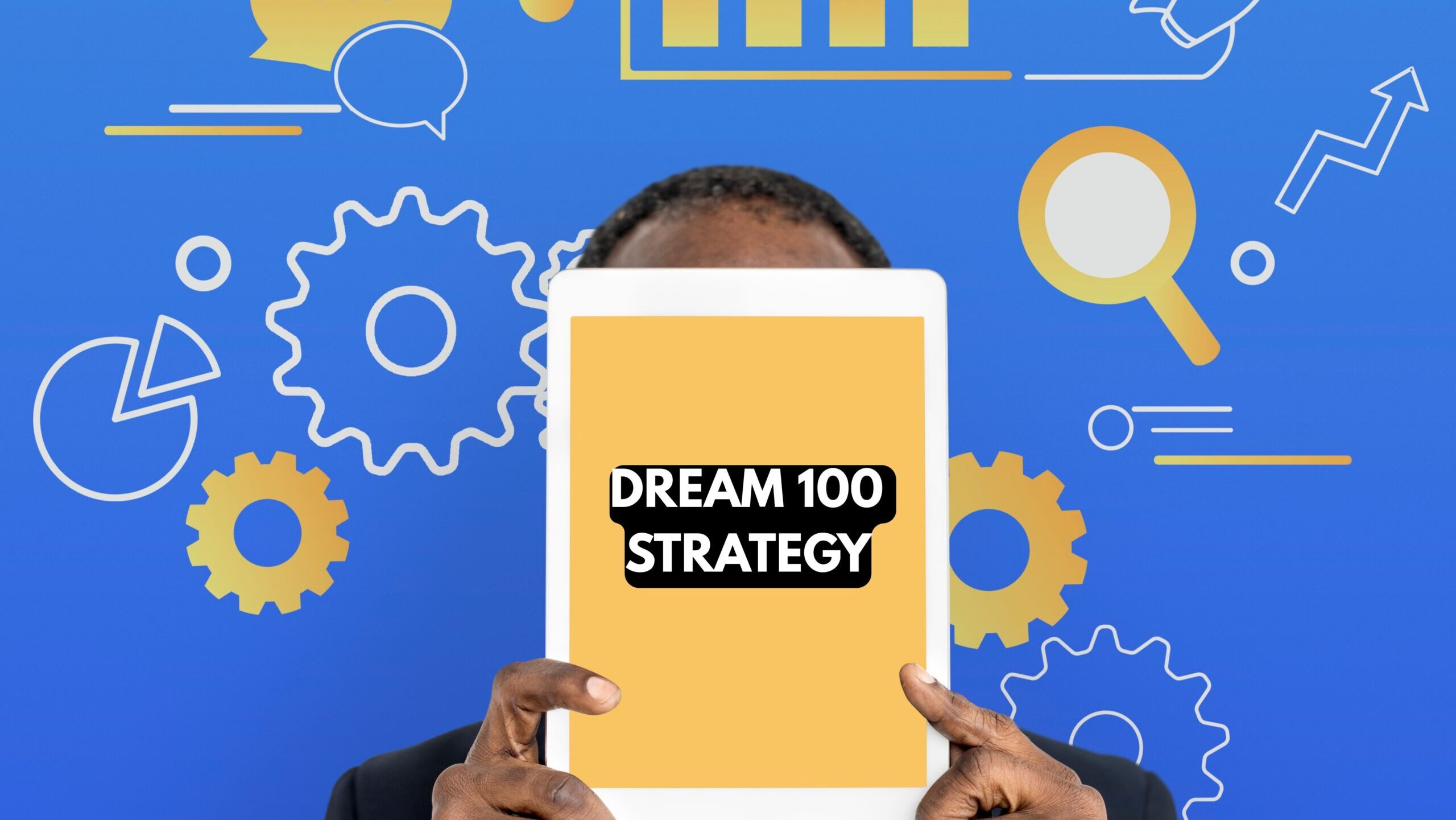
Introduction: Stop Competing—Start Partnering
If you’ve been grinding online—posting, emailing, and tweeting into the void—but still not seeing growth, you’re not alone. Marketing in 2025 is crowded. But there’s one underrated strategy that can dramatically shortcut your growth without a big ad budget: The Dream 100.
This is not a hack. It’s a high-leverage, relationship-driven method used by some of the world’s best marketers, from Russell Brunson to Chet Holmes, who originally coined the idea.
And the best part? Anyone—yes, even a beginner—can use it.
What Is the Dream 100 Strategy?
The Dream 100 is a marketing strategy that focuses on identifying the top 100 people, brands, or platforms who already have the audience you want… and building genuine relationships with them.
The Dream 100 Strategy is a powerful marketing approach that focuses on building relationships with 100 high-value individuals or businesses who already have access to your ideal customers. Instead of casting a wide net, you strategically identify and nurture connections with influencers, complementary brands, and industry leaders who can introduce your business to their established audiences. This could include podcast hosts in your niche, Instagram influencers with engaged followers, or businesses offering non-competing products to the same customer base.
The key lies in providing genuine value first, whether through collaborations, exclusive content, or mutual promotions before asking for anything in return. By consistently engaging with this curated list, you create a ripple effect that can dramatically expand your reach without expensive ad campaigns.
Instead of searching for leads out of thin air, you niche down to 100 most valuable leads
Influencers in your niche
- Podcast hosts
- Newsletter creators
- Bloggers
- YouTubers
- Business owners with your dream clients
The goal? Partner, collaborate, get mentioned, or get featured. Because when they talk about you, their audience listens.
Why the Dream 100 Works (Especially in 2025)
In an age of AI-generated content and constant noise, trust and credibility are everything. Consumers don’t trust ads as much anymore but they trust the people they already follow.
The Dream 100 strategy works because it leverages the power of targeted influence and established trust networks to amplify your brand’s reach exponentially. Instead of wasting resources on broad, impersonal marketing, you focus on building authentic relationships with 100 carefully selected influencers, complementary businesses, or community leaders who already have the attention and trust of your ideal customers—when they endorse or collaborate with you, their audiences are far more likely to engage with your brand than they would through traditional ads.
Here’s why the Dream 100 works so well today:
- You tap into existing trust
- It costs less than ads
- You gain long-term exposure, not just a traffic spike
- It builds REAL relationships, not just impressions
How to Build Your Dream 100 (Step-by-Step)

Step 1: Know Your Audience
To build your Dream 100 effectively, start by deeply understanding your ideal customer—their demographics, pain points, and online behavior (Step 1).
Next, identify where these customers congregate and who influences them, creating a list of 100 ideal partners including influencers in your niche, complementary businesses, podcast hosts, and industry leaders with engaged followings. Research each prospect’s content and engagement style to ensure alignment with your brand values, then prioritize them based on relevance and reach.
Develop a personalized outreach strategy, beginning with meaningful engagement on their platforms (liking/commenting) before making direct contact with tailored value propositions like guest content opportunities, exclusive offers for their audience, or joint ventures. Track all interactions in a CRM system, nurture relationships consistently without being pushy, and focus on providing ongoing value before asking for promotions. This strategic, patient approach transforms your Dream 100 from targets into genuine advocates who amplify your brand to their established audiences.
Before you set out to find your dream buyers, you need to know who they really are and what they want. Ask:
- Who are they already following?
- Where do they hang out online?
- What podcasts do they listen to?
- What YouTube channels do they binge?
You’re not trying to guess—you’re researching where attention already lives.
Step 2: Build the List (Don’t Overthink It)
Start by brainstorming platforms where your ideal customers already engage—Instagram influencers in your niche, podcast hosts, YouTube creators, LinkedIn thought leaders, or complementary businesses—and compile a raw list of 100-150 potential targets without overanalyzing perfection.
Focus on individuals or brands with engaged (not necessarily massive) followings, prioritizing those who align with your values and audience; tools like SparkToro or social media searches can help uncover hidden gems. Add notes on how you’ve already interacted with them (liked/commented on posts, bought their product) to personalize future outreach
Start with 20–30 names and grow it to 100 over time. Use tools like:
- Google + niche keywords (e.g., “Top finance blogs 2025”)
- YouTube search
- X (Twitter) and LinkedIn
- Podcast directories
- Instagram + TikTok for niche creators
Put these in a simple spreadsheet with columns like:
| Name | Platform | Niche | Contact | Notes |
|---|
Step 3: Give First—Always
The cornerstone of the Dream 100 strategy is generosity before asking for anything, provide meaningful value to your targets without expectations. Start by engaging authentically with their content (thoughtful comments, shares, or testimonials), then offer tailored gifts like free access to your product, exclusive data they can share with their audience, or introductions to valuable connections in your network.
For influencers, create custom content (e.g., graphics, videos, or swipe copy) that makes their job easier; for businesses, propose win-win collaborations like co-hosted webinars or bundled offers. This “give-first” mindset builds trust, distinguishes you from transactional pitches, and often inspires reciprocity organically whether through shoutouts, partnerships, or referrals because you’ve already demonstrated your investment in their success. Track these gestures in a spreadsheet (e.g., “Sent X a case study on 5/1”) to ensure consistent, personalized follow-ups that nurture relationships over time.
Now here’s the not-so-secret sauce: Don’t pitch cold. Provide value first.
That could mean:
- Sharing their content with thoughtful comments
- Leaving genuine reviews on their podcast or book
- Tagging them in content related to their work
- Sending a short message of appreciation—without asking for anything
People remember how you make them feel. Be memorable for the right reasons.
Conduct Industry Analysis in Seconds – For Free!
Discover how QuantexFlow can help you quickly analyze any industry with powerful AI-driven insights. Perfect for entrepreneurs, investors, and business analysts.
Try It Now – FreeNo credit card required. Get instant access to industry insights.
Step 4: Make the Ask—When It’s Time
Once you’ve built genuine rapport by consistently providing value—through thoughtful engagement, sharing their content, or offering free resources—it’s time to transition into a collaborative ask, but with precision. Craft a personalized, low-pressure proposal that aligns with their goals, whether it’s a guest post, joint webinar, or product collaboration, and frame it as a mutual win rather than a favor.
For example, instead of saying, “Can you promote my product?” try, “I’d love to create exclusive content for your audience on [topic they care about]—would a free guide or interview be valuable?” Timing is key: strike while the relationship is warm, and always make it effortless for them to say yes by handling all logistics or offering turnkey solutions. This strategic approach transforms your ask from a transactional request into an opportunity they’d regret missing.
Once you’ve shown up, engaged, and built familiarity, you can reach out. Your ask could be:
- A podcast interview
- A content collaboration
- An affiliate deal
- A shoutout in their newsletter
- A guest blog post
Keep it short, clear, and mutually beneficial. Example:
“Hi [Name], I’ve really been enjoying the way you share insights on [Topic]. I created a free resource that your audience might find helpful—would you be open to checking it out or sharing it if it’s a good fit?”
Relationships aren’t built overnight. Keep track of:
Step 5: Track + Follow Up
Follow up persistently but thoughtfully, spacing outreaches 7–14 days apart and adding new value each time, such as sharing their latest post with your audience, offering a free resource, or introducing a mutual connection. Personalize every touchpoint to deepen the relationship, and prioritize contacts who engage, adjusting your approach based on their responsiveness until you convert them into partners or advocates.
Consistency and genuine engagement turn cold leads into warm allies, ensuring no high-potential connection falls through the cracks.
Relationships aren’t built overnight. Keep track of:
- When you engaged with someone
- What they posted
- How they responded
Even if someone doesn’t say yes today, they might in 6 months. Stay visible—without being spammy.
🚀 Fund Your Startup Dream
Get the complete guide to securing startup loans and launch your business with confidence!
- ✓ All loan types explained
- ✓ SBA & alternative options
- ✓ Application tips & tricks
Real-Life Example: How I Got My First 500 Blog Visits
I had no audience, no budget—but I had a Dream 100 list.I found 10 finance bloggers whose readers were exactly who I wanted. I left comments on their blogs, shared their posts with insights on Twitter, and sent 2 of them a free printable I made. One of them shared it in their newsletter.
Result? 517 blog visits in 3 days.
No ads. No begging. Just value.
Common Mistakes to Avoid
- Sending copy-paste DMs
- Making it all about you
- Asking too soon
- Not following up
- Ignoring smaller creators (they often have better engagement!)
Final Thoughts: It’s Not About Numbers, It’s About People
The Dream 100 strategy isn’t about quick wins—it’s about building real relationships that scale your impa
Whether you’re launching a course, a blog, a product, or even a podcast, the fastest way to grow is to connect with the people your dream customers already trust.
Start with 10. Give more than you take.
Then grow from there.
Dream 100 Strategy FAQs
Click questions to reveal targeted outreach secrets
How do I identify my perfect Dream 100 list?
1. Audience Match: Who already serves your ideal customers?
2. Influence Level: Micro-influencers (10k-100k followers) often convert best
3. Content Style: Look for alignment with your brand values
What’s the best way to initially contact them?
Comment meaningfully on 3+ posts
Share their content first
Mention mutual connections
Hyper-personalized emails
Video messages
Invitations to collaborate
What value can I offer to get their attention?
- Exclusive content for their audience
- Co-created products/services
- Revenue-sharing opportunities
- Cross-promotion packages
- Testimonials/case studies featuring them
How long does it typically take to see results?
Weeks 1-4: List building and initial outreach
Weeks 5-8: First collaborations secured
Months 3-6: Compound results from multiple partnerships
Pro Tip: Track response rates to refine your approach



Pingback: How to find new customers and increase sales in 2025 25